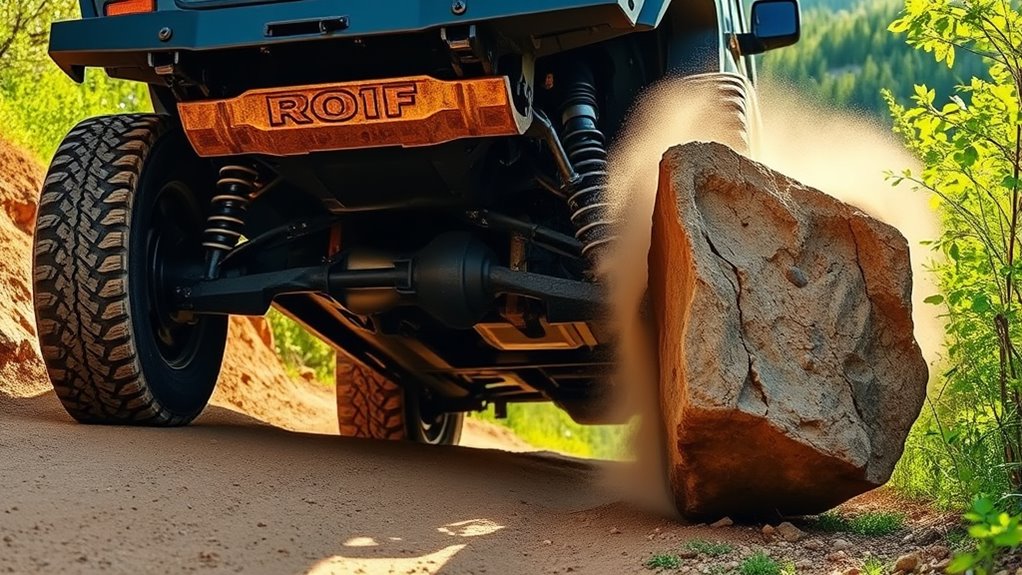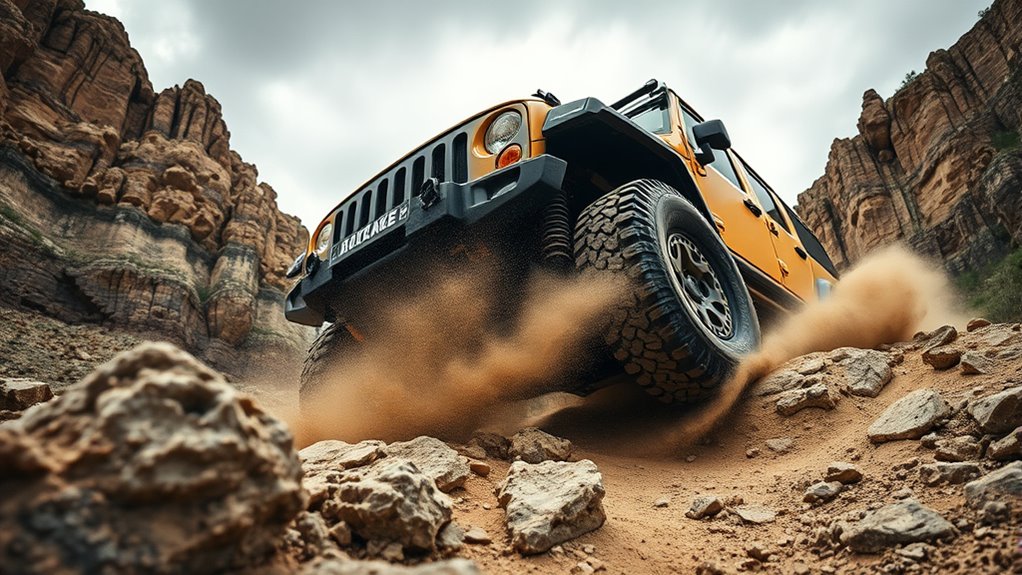Ground clearance, approach angle, and departure angle are key to off-road success. Ground clearance measures how high your vehicle’s undercarriage is from the ground, helping you clear obstacles without scraping. Approach and departure angles indicate how steep an incline or decline you can navigate safely, preventing damage to bumpers or undercarriage. Improving these aspects through modifications boosts your vehicle’s ability to tackle rough terrain confidently. Keep exploring to learn how to optimize these features for your adventures.
Key Takeaways
- Ground clearance is the distance between the vehicle’s undercarriage and the ground, affecting obstacle clearance and terrain navigation.
- Approach angle determines the maximum obstacle slope the front of the vehicle can ascend without contact.
- Departure angle indicates the steepness of descent the rear can handle without scraping or damage.
- Modifying vehicles with lift kits and skid plates can improve ground clearance and approach/departure angles for off-road use.
- Proper evaluation of these angles and clearance helps prevent vehicle damage and enhances off-road performance.

When choosing a vehicle for off-road adventures or challenging terrains, understanding ground clearance, approach angle, and departure angle is essential. These three factors determine how well your vehicle can handle obstacles without getting stuck or damaged.
Ground clearance is the distance between the lowest part of your vehicle’s undercarriage and the ground. The higher the clearance, the better your vehicle can clear rocks, logs, or uneven terrain without scraping or getting hung up. It’s especially important when you plan to steer through rough trails or rocky paths because it directly influences the obstacles you can safely pass over.
Ground clearance affects your vehicle’s ability to navigate rocky, uneven terrain without scraping or getting stuck.
Approach and departure angles are angles measured from your vehicle to the obstacles it can approach or leave without hitting. The approach angle is the maximum angle of a slope or obstacle that your vehicle can ascend without the front bumper or undercarriage making contact. Think of it as the steepness of the hill you can climb without your front end scraping.
The departure angle works in reverse, indicating the steepness of a slope you can descend without the rear bumper or undercarriage hitting the ground. Both angles are shaped by your vehicle’s design — including bumper height, wheelbase, and suspension — and have a direct impact on your ability to tackle steep or uneven terrain.
When you’re out on the trail, having a good ground clearance means you can approach rocky sections or rutted paths with less concern about bottoming out. But even with high clearance, if your approach angle is too shallow, you risk hitting the front bumper on a steep incline.
Similarly, if your departure angle isn’t sufficient, you could damage the rear of your vehicle when descending a hill or crossing a ledge. To optimize these angles, some drivers install lift kits, aftermarket bumpers, or skid plates that increase clearance and improve approach and departure angles.
However, these modifications can alter your vehicle’s center of gravity and handling, so weigh the benefits against potential drawbacks. Understanding these specifications helps you choose the right vehicle and make modifications to suit your off-road ambitions.
It also guides you in evaluating the terrain you’ll encounter, so you can avoid getting stuck or damaging your vehicle. Being aware of vehicle modifications that enhance these factors can significantly improve your off-road performance. Always remember, a vehicle with high ground clearance and favorable approach and departure angles will give you more confidence and capability when facing tough obstacles.
Whether you’re climbing over rocks, descending steep slopes, or steering through tricky trails, knowing these specifications ensures you’re prepared for whatever terrain comes your way.
Frequently Asked Questions
How Does Ground Clearance Affect Off-Road Vehicle Stability?
Higher ground clearance improves your off-road vehicle’s stability by preventing the undercarriage from hitting obstacles, allowing you to navigate rough terrain more confidently. It reduces the risk of getting stuck or damaging crucial parts, especially on uneven surfaces.
However, too much clearance can raise the center of gravity, making your vehicle more prone to tipping. Balance is key to maintaining stability while gaining the benefits of increased ground clearance.
What Are Optimal Approach and Departure Angles for Steep Terrain?
You’ll want an approach angle of around 30 degrees and a departure angle near 30 degrees for steep terrain—because, of course, the steeper the hill, the more you’ll need to avoid scraping your bumper or rear.
These angles help your vehicle clear obstacles without damage. Just remember, it’s not about being daring; it’s about being smart. Keep your angles in check, and you’ll conquer those steep trails with confidence.
Can Increased Ground Clearance Compromise Vehicle Handling?
Increasing ground clearance can compromise your vehicle’s handling because it raises the center of gravity, making the vehicle more prone to body roll and less stable during sharp turns or quick maneuvers.
You might notice a softer ride or less precise steering, especially at higher speeds. While higher clearance helps with obstacles, it’s important to balance it with suspension adjustments to maintain good handling and safety on various terrains.
How Do Aftermarket Modifications Impact Angles and Clearance?
You might worry that aftermarket modifications could ruin your vehicle’s angles and clearance, but they don’t have to. If you choose quality parts and have them installed properly, you can enhance your vehicle’s capabilities without sacrificing handling or safety.
Just be mindful of how each change affects your angles, and consult experts. This way, you get the best of both worlds—performance improvements and confident navigation on any terrain.
What Safety Considerations Relate to Ground Clearance in Rugged Environments?
You should prioritize safety by ensuring your vehicle has adequate ground clearance for rugged environments to avoid undercarriage damage. Be aware that low clearance increases the risk of getting stuck or damaging essential components on uneven terrain.
Regularly inspect your vehicle for clearance issues, and consider modifications carefully. Drive cautiously, especially over rocks or rough terrain, and plan routes that minimize the risk of scraping or getting stuck.
Conclusion
Understanding ground clearance and approach & departure angles can feel like mastering rocket science, but it’s simpler than you think. When you pay attention to these specs, you’ll avoid getting stuck in the most epic off-road battles. Think of it as giving your vehicle superhero armor—saving you from embarrassing scrapes and daring stunts. Master these, and you’ll conquer trails like a legend, turning every off-road adventure into a triumphant, jaw-dropping journey.









